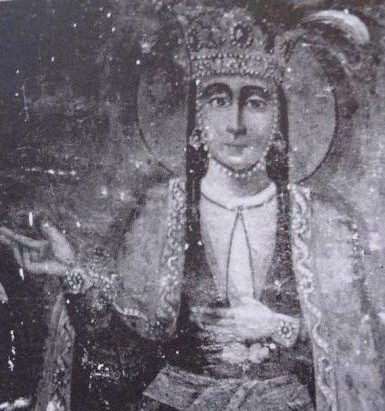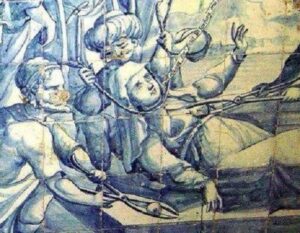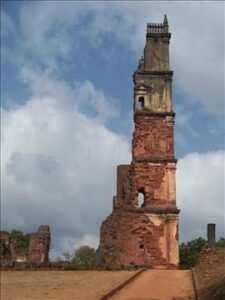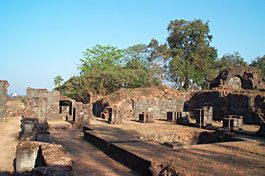In 1614, It had been over a hundred years since the Portuguese took Goa from the Bijapur Sultanate. Grand churches were built and more were being built. Besides Old Goa, the ‘Rome of the Orient’ was expanding every day. A recently built St. Augustine Church (1602) stood 46 metres high. The church was one of the most magnificent churches built during that period. Only ten survive today (out of which four are chapels). 13 years later relics believed to be of a Georgian queen would be brought and kept in the colossal church complex. Thus, began the saga of Queen Ketevan in Goa.
Queen Ketevan
1581, Ketevan was married to Prince David of Kakheti future King of Kakheti (in Georgia). David did not rule for long. His reign lasted from 1601 to 1602. After David’s death in 1602, Ketevan involved herself with charity while David’s father Alexander II ruled the Kingdom. Constantine I, younger brother of David I, killed his father and tried to take over the kingdom. He was defeated by forces rallied under Ketevan. Constantine was killed in the battle. It was Ketevan’s treatment of enemy forces that earned her much respect on both the sides.
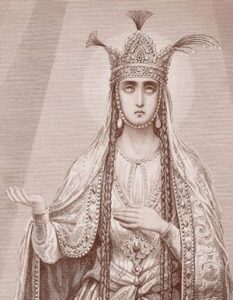
She established her underage son Teimuraz I, as the king of Kakheti after negotiating with the Safavid Emperor Shah Abbas I of Iran (suzerain over Georgia). Queen Ketevan acted as the regent till the young king was old enough to rule. The relations between Teimuraz I and Shah Abbas I reached a low point in 1614. To assure the emperor of his loyalty Teimuraz I sent two of his sons and his mother Queen Ketevan into the Emperor’s custody.
Hostage in Shiraz
Queen Ketevan endured a long exile from home as a ‘honorary hostage’ in the Iranian city of Shiraz. It is here that she came in contact with two Augustinian Friars. The friars respected the queen a lot and held her in high regard.
1624 – Ketevan the Martyr
Hostilities between the Teimuraz I and Shah Abbas I were again flared. In an act of revenge Abbas I, asked Queen Ketevan (an honorary hostage) to convert to Islam and join his harem. The Queen in her mid-60s refused to do so. Her refusal to convert angered the Shah. For this, the Queen Ketevan was tortured to death.
Queen Ketevan’s struggle was witnessed by the two friars. In 1627-28, as an act of loyalty to the queen the Augustinian friars exhumed and smuggled her remains out of Persia. the remains were sent to her grateful son Teimuraz I. A bone from her right hand and palm was taken to Goa by Portuguese friars to the Augustine monastery in Old Goa.
Goa
The St.Augustine complex was abandoned in 1835. After that much was lost from the complex which collapsed into ruins over the years. Today only a tower from the Church’s facade survives. It is here that the Queen’s relics were kept.
The fact would have gone unnoticed if not for a book by an Armenian historian Roberto Gulbenkian in 1985 lead to a clue. Since 1989 Many Georgian delegations searched for the relics but not much was found. It was in 2004 after clearing nearly 2 meters of rubble a tomb of Manuel de Siqueira on the floor of the abandoned church was found.
A Clue
During that time Sidh Mendiratta (researcher) was a Portuguese exchange student studying architecture in Goa. Doing research for his final project in which he was to build a model of the St.Augustain Church in its prime. Mendiratta found the name to be familiar. In order to unravel the mystery behind the name, he began to go through various documents in the library. What he found in his search lead to a flicker of hope of unravelling the Queen’s relics.
The tomb of Manuel de Siqueira was mentioned to be situated in a place called chapter chapel by Silva Rego in his 1958 collation of historical documents in regards to Portuguese missions in the East. This was also probably the first clue that led to the searches in Goa but the searches happened in the wrong places.
In the 12th volume of the document, all the tombs in the Augustinian complex are recorded. The document states Chapter chapel contains the tomb of Manuel de Siqueira along with the relics of Queen Ketevan in a black box.
2004 – 05
In 2004, Nizamuddin Taher (head of Archeological Survey of India Goa circle) was undertaking the excavation efforts. the efforts weren’t started with the specific purpose of finding the Queen’s relics but to clear the complex of debris so that visitors could enter it. Chasing the lead found by Mendiratta both began to look for the relics. They had to return disappointed as the relics were not found that year and the site was closed down for the season.
The efforts were resumed in 2005. As soon as excavation efforts began; pieces of bones were discovered. More bones were found in the proximity of the first find. These two sets of bones were meticulously analysed using DNA found in them. The aptest technology at the Centre for Cellular and Molecular Biology (CCMB), Hyderabad was put to use.
Latest updates
The research was so serious that saliva samples from far away Georgia were gathered and tested. It was determined that one set of bones originated from Georgia and the other set of bones originated to India. After that, it is believed by many that the bones are indeed that of Queen Ketevan who is revered as a saint in her country.
Although the evidence strongly points that the bones belong to Queen Ketevan. It is yet to be confirmed. However, one thing is conclusive that the bones do belong to a Georgian.

